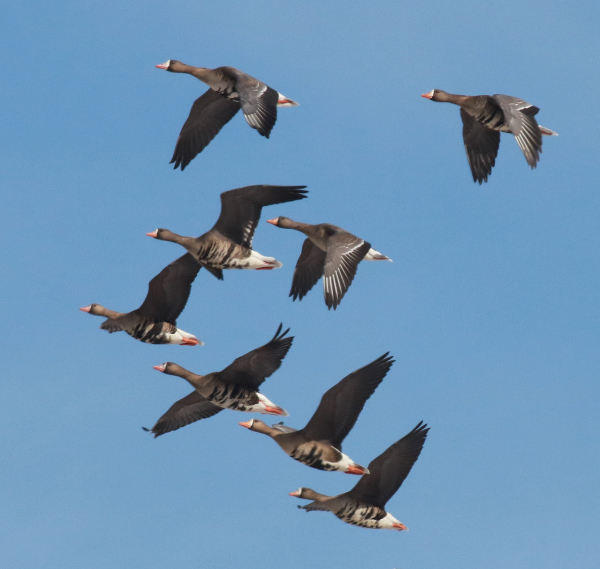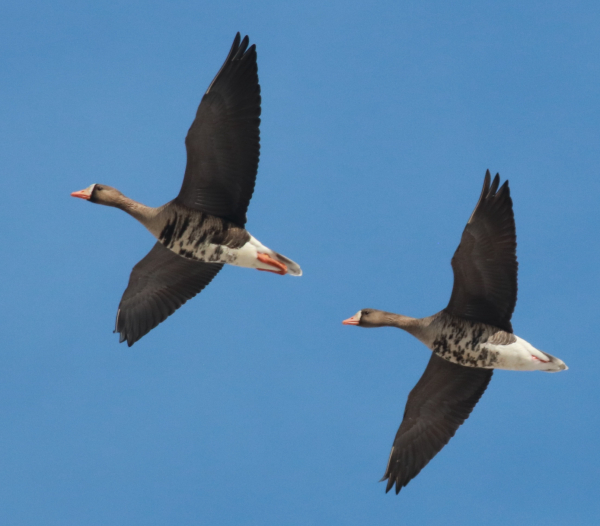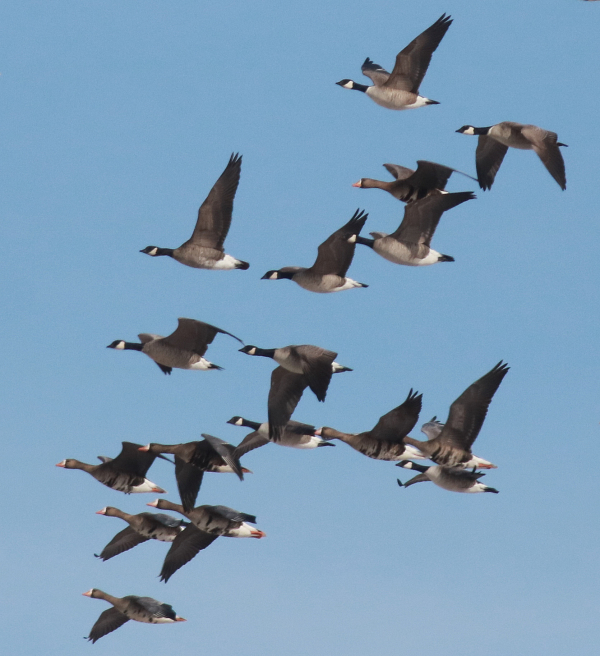
For more than an hour, flocks of White-fronted Geese passed by between a shallow-water resting area and a harvested field where they fed on waste kernels of corn. The opportunity to enjoy the sights and sounds of goose flocks passing in close proximity was invigorating.

Although they tend to look gray from a distance, White-fronted Geese have some distinctive white and black coloration, and their bill and feet are colored orange. The black markings on the breast and belly of adult White-fronts creates a unique pattern for each goose. First year White-fronts lack the black markings.

A number of mixed flocks of Cackling and White-fronted Geese provided a special opportunity to photograph the two species together. The Cackling Geese are much smaller than similar-looking Canada Geese.
|
Tuesday’s birding thrill was the first Rough-legged Hawk of the season flying just three miles north of my office, but the real thrill of the week was Friday the 13th when the sunshine pulled me away from the office with Sand Lake in mind – hoping to see some migration in progress. Sand Lake, of course, is the fabled Sand Lake National Wildlife Refuge, a remarkable waterfowl concentration site about 15 miles south of the border of the Dakotas, where the northern tip of the iceberg for the Great Plains goose migration had advanced, with a million more to come.
I was excited to spend some time among the Arctic-nesting Geese as they press forward into the icy edges of the James River Valley. The James is about 35 miles east of home, Sand Lake Refuge is about 40 miles farther south, so I make it on site in about an hour and a quarter. I was surprised I didn’t see periodic flocks of Snow Geese along the way, but a lone Red-tailed Hawk about 18 miles into the drive was the only suggestion there was any migration happening.
This trip, I wasn’t running on a hunch or taking the pulse of nature without knowing what’s around the next corner. I called ahead to the refuge office to ascertain this would be a fruitful trip. I was assured the first geese and ducks had arrived, followed by Bald Eagles. I found the first flocks of geese lined the edges of the trickle of open water – mostly Canada Geese mixed with a few Cackling Geese – along with flocks of Mallards standing on the ice and a few male Common Mergansers swimming in the icy water. Almost immediately a couple small flocks of White-fronted Geese took wing and I followed them to see if I could get any photo opportunities of the birds on the wing, but after a half-hour of trying this angle without payback I decided to reposition south of the refuge headquarters where I’ve had better luck.
As I drove, there were flocks of hundreds and hundreds of Snow Geese flying very high, passing eastward. About five miles south, I found many hundreds of geese spread out across a shallow expanse of open water with big flocks of Snows flying high overhead. Some Canada Geese began crossing in front of me to join a growing feeding flock, and more White-fronted Geese followed from the shallows to the feeding field, so I picked a position where the geese would pass by me with the sun at my back and the best light highlighting the low-flying geese – mostly White-fronts, with some small flocks of Cackling Geese, some mixed Cackling and White-fronted flocks, and periodic flocks of Canada Geese.
It was exciting to have the White-front flocks passing by, flying low and calling their unique calls that I absolutely enjoy. I spent 50 minutes photographing flock after flock, occasionally waiting for the sun to reappear from behind a passing cloud. In addition to the geese, every once in a while a small flock of ducks flew overhead, Mallards, Northern Pintails, and mixed flocks of Mallards and pintails – fun. Periodically through the whole afternoon, the sky would fill with huge flocks of Snow Geese flying very high, but they always vanish east or west – none were landing. Even so, I thoroughly enjoyed the White-front and Cackling action until an incoming cloud bank sent me packing.
On my way home I counted five Bald Eagles one by one, two lone Red-tails, one Merlin, and one kestrel. I also checked on the first nesting Great Horned Owl I found this year – two weeks ago. She was dutifully incubating her rapidly developing eggs, and I caught sight of a new Bald Eagle nest not quite two miles north of the owl, which contained an incubating Bald Eagle – both nests are about 50 miles southeast of home. Ya’know, Friday the 13th is always a good day for me.
Saturday Rerun
Saturday, while writing about photographing the Sand Lake geese, a bright surprise popped out of the clouds – the sun – and when I saw blue sky to the south I was doubly surprised. Hmm; I quickly double-checked the weather report for Aberdeen, South Dakota, located a half-hour south of Sand Lake, and with a change in the forecast boasting a clear sky for the rest of the afternoon, after a few moments of angst, I dropped everything and took off to photograph White-fronted Geese again! Now that’s a wonderful level of freedom that paid great personal rewards Saturday afternoon.
Again, there were few birds to be seen along the way – a Western Meadowlark a half-mile south of my office, a Red-tailed Hawk 33 miles down the road, another when I had 52 miles on my trip odometer, and one more just before reaching the refuge perimeter – oh, and a Rough-legged Hawk and a female Northern Harrier, both seemingly cringing from the cold northwest wind (27 degrees without the wind chill).
The rest was almost an exact rerun of the day before, same birds, same places – but the photo action was even better! Although I checked the area out a bit more to the south, I happily settled back to the same photo pass where flocks of hungry geese – White-fronts, Cackling, and Canada Geese – flew low from their resting area in the shallows surrounding the flow of the James River, to an expansive roadless area of harvested agricultural fields to feed in concentrations numbering in the thousands. This afternoon they were joined by flocks of Snow and Ross’s Geese, although the white and blue geese were much more cautious: They flew in from another direction on high, then whiffled almost straight downward to the feeding site.
I greatly enjoyed photographing the on-coming flocks, then following them through my camera viewfinder as they winged broadside before passing onward. The sound of each flock and the overall goose music was a fitting call of the wild to orchestrate the cloudless blue sky. What fun I had! Being Saturday, I encountered several other cars of people in the area. It was fun to see other interested birders, undoubtedly enjoying the earliest avian arrivals by their thousands. This time, unhampered by clouds, I photographed about 90 minutes, until it seemed all the geese had transferred from the water to the feeding field.
Eagle Pursuit
In the midst of the goose action, out of my peripheral vision I caught motion that directed me to my left: It was a Bald Eagle flying just above ground level in hot pursuit of a Cackling Goose. The ensuing flight didn’t look even close to having predatory potential, but the eagle pressed on as the Cackler tried to outdistance the big raptor, then swung in a big circle across the open field in front of me, rarely flying more than five feet above ground. The chase took on a new dimension when the eagle raised upward another five feet to gain elevation that it used to dive forward, a ploy most often used by hunting falcons, and this push of acceleration seemed to make all the difference as the intent eagle closed in on the goose.
In a last move to evade the eagle’s talons, the goose flew higher, but as it did, the eagle intercepted it from behind and below – the noble Cackling Goose probably was already in a state of shock when the eagle caught it in mid-air. I was really surprised; surprised by the eagle’s prolonged attention to the attack, surprised it caught up to the goose, and impressed that it caught the Cackler. It may have been the most impressive pursuit flight I’ve ever witnessed by any bird of prey. I photographed what I could of the action, even though I was too far away for quality images, but I was able to document moments of the pursuit and attack. As exhilarating as it was, I certainly didn’t hope for the Cackling Goose to be caught, and I was surprised and a bit stunned by the outcome. Yet, geese feed, eagles feed, and the two meadowlarks in the field feed too.
That was the first eagle of the day, and although I didn’t see any Bald Eagles at the refuge the day before, I eventually found 14 Saturday, along with another one 11 miles to the west. Part of the reason I reacted quickly and decisively to return to Sand Lake was that there were no sunny days predicted for several days, and things could change dramatically between now and then, with a million geese flowing north en masse in a few hours! Plus, I had such a good time Friday, within a moment’s option I decided indeed I wanted to give it another go! Hooray! But with luck, some fraction of a million Snow Geese will join hundreds of thousands of White-fronts, Cacklers, Ross’s, and Canada Geese that assemble at Sand Lake during a prime spring – not to mention a dozen species of ducks and many, many more eagles.
Then too, soon there will be thousands of these five species in my own neighborhood, hopefully for weeks of goose music and photo opportunities, along with many other exciting spring migration finds – we’re just getting started! Keep in mind, the official first day of spring comes a bit early this year – Thursday, March 19th (the day after this issue is published). Vow to make the most of your spring birding season – I predict it will be a migration to remember!
Article and photos by Paul Konrad
Share your bird sightings and photos at editorstbw2@gmail.com